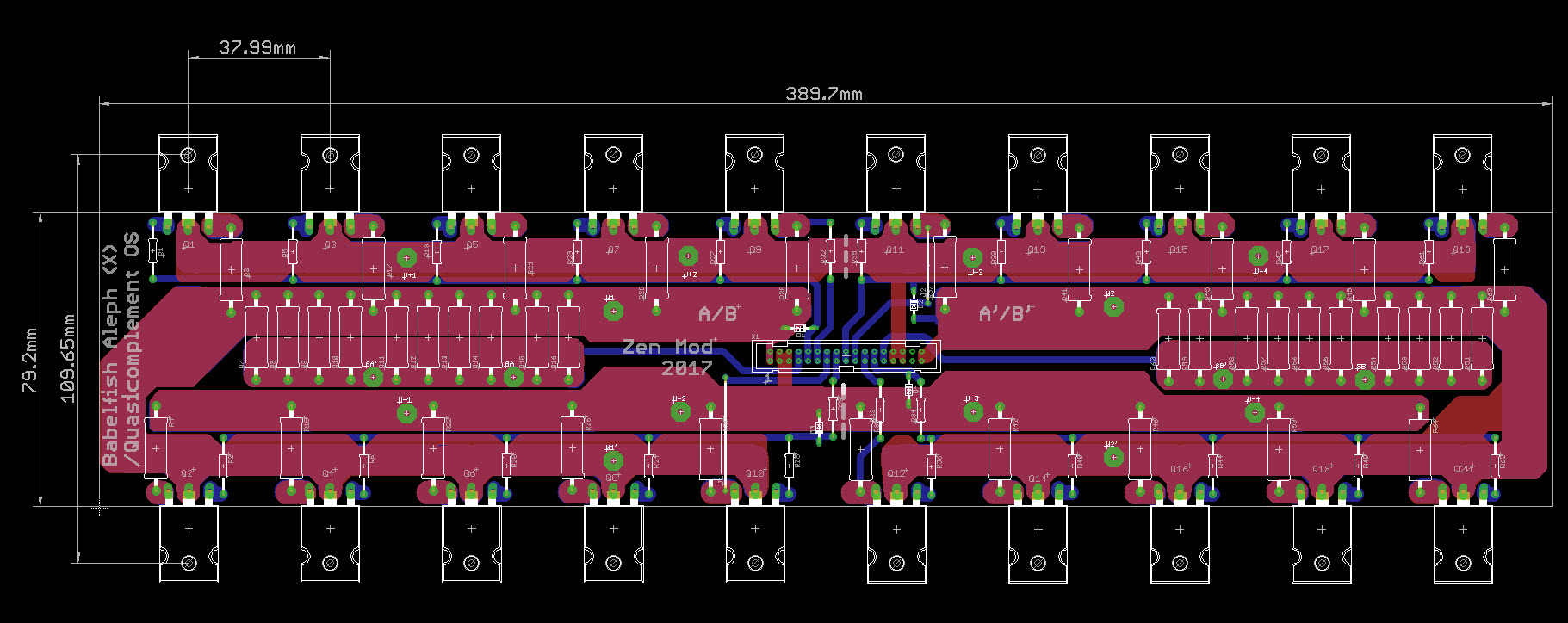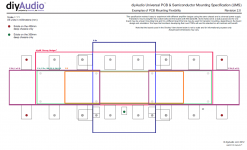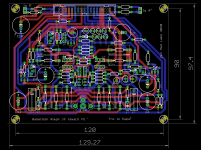Hi ZM,
As per my previous post, here are some questions that I had regarding the input stage module.
- Q2, Q3, Q11 & Q12 are all BD139. Two IPS boards requires 8x BD139. You did send me 8x in total but one pack of 6 that is written "all matched" and 2 that are written "random". If these four transistors need to be matched, then I'm short 2 devices from the "all matched" BD139. Do they need to be all matched, and if yes, I bought a pack of 20 to make another 8 matched devices. If they need to be matched, what are the parameters I'm looking for and how did you test them for matching?
- Since I'm reassembling two new IPS boards, I don't have BC639. They seem to be obsolete at Mouser and Digikey, unless I'm not looking at the right number. I did manage to find some BS63916 but the parameters are a little different. What should I do?
- Do you have a hookup diagram of the whole IPS, OPS, PSU? Vitali sent me some pictures and it seems as the gnd (0V) only connects on the IPS and it is not connected directly from the PSU to the OPS.
View attachment 812958
Again, thanks for everything!
Do
practically , just Q3-Q12 need to be matched , cascodes are irrelevant
with BS63916 , is that typo - you meant BC63916 ( which is probably BC639-16, where 16 means just classification by Hfe)?
anyway - those at Mouser are BC639-16 , marked in funny way , so they're good ( two types , one of them being 512-BC63916_D27Z , lazy to go back and grab code for second)
didn't I just sent you spare BC639 , along with spare input JFets ?
I'll make hookup sketch and post here ; there is no reason that GND goes to OS pcbs
anyhow , good that you reminded me , I'm going to check already made pcb files for that , do some cosmetic work and order them soon ........ as I remember, I had idea that existing OS pcbs are already good for one pcb/one channel , with two cuts of traces on logical places
very good to know
LOL, BS639... Yeah, for sure I meant BC639. They have not yet made the bullshitt639 part yet... Don't know what I was thinking! Ok, let me check in the bag of parts for it, I thought I saw something else...
Thanks in advance for the hookup sketch!
Do
Thanks in advance for the hookup sketch!
Do
though , no matter what amount of outputs one intend to use , I think that lowest practical figure for dissipation is around 200W per channel .
[. . .]
as far as I'm able to comprehend , that would be +/-18Vdc rails , 5 mosfets per quadrant (so 20 per channel) , source resistors 1R , Iq aroundish 500mA per vertical pair, sum Iq aroundish 5A
In the spirit of simplicity (or avoiding matching output devices), why not use one IRFP150/250 per quadrant? 18 Vdc x 2.5 A is only 45 W per device, and I believe that those devices are comfortable up to about 50 W each with sufficient heatsink.
you can use one 150 per quadrant , it'll change pair of 240
though , enough for mini X amp ........ and I don't think that's wisest thing to start with
go big , or simply build some other smaller amp
though , enough for mini X amp ........ and I don't think that's wisest thing to start with
go big , or simply build some other smaller amp
go big , or simply build some other smaller amp
I have about 400 W of heatsinks, and I'm trying to figure out what to do with them. For a midsize option (30 W - 40 W into 6 to 8 Ohm) a 30 V complementary output BA-3 would certainly be easiest and most efficient, but in the realm of single-ended designs, it seems like the following two options are front-runners:
1. Babelfish J w/ 30 V rails (will require paralleled devices for 2.5 A Iq)
2. Babelfish JX w/ 18 V rails (no apparent need for paralleled devices)
As between 1 and 2, are you suggesting that the J design is better suited for a midsize amp?
Last edited:
can write half a page of reasons , but sleepy and lazy and prone to mistakes when sleepy
so , in short - simply J
24Vac secondaries , two pairs of IRFP150 outputs , hasta la vista
so , in short - simply J
24Vac secondaries , two pairs of IRFP150 outputs , hasta la vista
can write half a page of reasons , but sleepy and lazy and prone to mistakes when sleepy
so , in short - simply J
24Vac secondaries , two pairs of IRFP150 outputs , hasta la vista
Much appreciated!
Zen Mod,
Is there any news about lower version of amplifier using one channel on each heatsink
Is there any news about lower version of amplifier using one channel on each heatsink
FE for 5-deep
so , one big OS pcb per channel ...... so it's possible to make stereo amp in one (big) case
even other solutions possible , if one use something as Daughter boards I made for Babelfish J on Steroids (each small pcb covering 3 mosfets)
somehow I'm starting to be familiar with Papa's constant lack of time and latest  occurrence in posts
occurrence in posts
too much things on my plate , can't exactly maintain speed of prototyping and making things with speed of ideas for new thingies
have pcbs as files, "all" I need is to find some time to test them
ordering FE pcbs is trivial, time is of essence
what can I say , without lying both to you and me ........ gimme a month and half

 occurrence in posts
occurrence in posts too much things on my plate , can't exactly maintain speed of prototyping and making things with speed of ideas for new thingies
have pcbs as files, "all" I need is to find some time to test them
ordering FE pcbs is trivial, time is of essence
what can I say , without lying both to you and me ........ gimme a month and half

Zen Mod,
Is there any news about lower version of amplifier using one channel on each heatsink
I think 5U UMS heatsinks would be ideal for that.
Could fit up to 16 TO-247 transistors.
Attachments
if you're going to build that kind of an amplifier, little tapping should not scare you
I already have OS pcbs made for big one, which is 10 pairs per pcb; applicable either for two quadrants ( big amp, 10 mosfets per quadrant, needing 2 OS pcbs for amp channel) or 4 quadrants (smaller amp, 5 mosfets per quadrant, needing 1 OS pcb for amp channel)
OS pcb being 79mmx390mm , with mosfets holes at 110mm ....... it can go even in 400mm deep Modushop case , but my advice is to use 5U/500 Modushop case
there will be plenty of heat and you need all the chunk to get rid off it
edit: see post #5
one pic from there :

I already have OS pcbs made for big one, which is 10 pairs per pcb; applicable either for two quadrants ( big amp, 10 mosfets per quadrant, needing 2 OS pcbs for amp channel) or 4 quadrants (smaller amp, 5 mosfets per quadrant, needing 1 OS pcb for amp channel)
OS pcb being 79mmx390mm , with mosfets holes at 110mm ....... it can go even in 400mm deep Modushop case , but my advice is to use 5U/500 Modushop case
there will be plenty of heat and you need all the chunk to get rid off it
edit: see post #5
one pic from there :
Last edited:
My precision in drillig holes is scary awfull thought.. 😀
That's why I suggested UMS heatsink for smaller amp.
But if it will not be UMS compatible then i guess we can always order heatsinks from modushop with another drill tempalate.
That's why I suggested UMS heatsink for smaller amp.
But if it will not be UMS compatible then i guess we can always order heatsinks from modushop with another drill tempalate.
I think I got it now.
Big one 20 mosfets for half a channel, and small one 20 mosfets for a chennel.
So mosfets spacing template would stay the same?
Big one 20 mosfets for half a channel, and small one 20 mosfets for a chennel.
So mosfets spacing template would stay the same?
These heatsinks does look Impressive
just like Impressions from amplifier
just like Impressions from amplifier
The comments above made me very curious I said I want to try it 🙂
Tonight I managed to finish a mono BJX channel (100W)
I did not abstain and played a bit of music.
I expected to be fine, but ... I have not been so impressed for a long time. It's extraordinary ! And I subscribe to everything Slowikpl wrote!!!
And yes, combine the best of XA.05 and XA.08. I am really impressed, very silent, the voices come out of the night and am amazed with their warmth and clarity. And bass ... very special.
Thanks a lot to ZenMod for this project, for the patience she had with me, there were some problems. But I managed to solve them. One tip, if you put only one pair or two MOSFETs for testing on the PCB, do not try to connect a speaker. I did it and I could not understand why I have oscillations in both channels. I've lost a lot of time before I realize that I have to put all MOSFET on the PCB. After I did it, everything went back to normal and it was fine. (between Hot Out and GND am 250mV, between both Hot OUT am 10mV) Bias 350mA on each MOSFET after 2 hours has not changed, as well as offset- very stable)
And the most important - the sound is super cool!
OK, ya got me there
had some pcbs to order, so did final checks and tidy up of these, and they're ordered too
hope it'll not share destiny of fully populated Babelfish XA25 pcbs, waiting to put them on bench, for almost 2 years now
had some pcbs to order, so did final checks and tidy up of these, and they're ordered too
hope it'll not share destiny of fully populated Babelfish XA25 pcbs, waiting to put them on bench, for almost 2 years now

Attachments
Zen Mod,
very nice to hear you will proceed further
I really want very much to have JX amplifier with more headroom, using more than just one pair output devices capable to drive lower than 8 ohm loads
Being one case design suppose less work but still enough power
I guess there will be Interest for that version of amplifier
very nice to hear you will proceed further
I really want very much to have JX amplifier with more headroom, using more than just one pair output devices capable to drive lower than 8 ohm loads
Being one case design suppose less work but still enough power
I guess there will be Interest for that version of amplifier
remember that base is still Aleph circuit, so amp not being able to leave A class envelope
big one was 100W/8R and 70W/4R
smaller one, if contained to -say - 130W of heat per channel ( possible in big 5U/500) will end in some 50W/8R and 35W/4R
heat/power ratio better than non-xed Aleph, but you can't beat physics
Robert (my guy from Poland, owner of big ones) chose that as his personal preference over numerous original PL amps, all of them being able to cross in B class, so practically unlimited power ..... at least when talking about biggies ( and he tried them in his system while deciding what to buy)
big one was 100W/8R and 70W/4R
smaller one, if contained to -say - 130W of heat per channel ( possible in big 5U/500) will end in some 50W/8R and 35W/4R
heat/power ratio better than non-xed Aleph, but you can't beat physics
Robert (my guy from Poland, owner of big ones) chose that as his personal preference over numerous original PL amps, all of them being able to cross in B class, so practically unlimited power ..... at least when talking about biggies ( and he tried them in his system while deciding what to buy)
- Home
- Amplifiers
- Pass Labs
- Babelfish XJ , or JX …….. or whatever (Aleph X servo for Greedy Boyz)

